Photosynthesis in Higher Plants - Revision Notes
CBSE Quick Revision Notes
CBSE Class-11 Biology
CHAPTER-13
PHOTOSYNTHESIS IN HIGHER PLANTS
Photosynthesis is a physico-chemical process by which green plants use light energy to drive the synthesis of organic compounds. It is an enzyme regulated anabolic process.
- Photosynthesis is the basis of life on earth because it is the primary source of all food on earth and it is responsible for release of in the atmosphere.
- Chlorophyll, light and is required for photosynthesis. It occurs only in green part of leaves and in presence of light.
Early Experiments
- Joseph Priestley in 1770, on the basis of his experiments showed the essential role of air in growth of green plants. A mouse kept in closed space could get suffocated and die but if a mint plant is kept in bell jar neither candle will extinguish nor will the mouse die. He concluded that foul air produced by animal is converted into pure air by plants. Priestley discovered Oxygen gas in 1774.


- Julius Von Sachs in 1854 shows that green part in plants produces glucose which is stored as starch. Starch is the first visible product of photosynthesis.
- T.W.Engelmann (1843-1909) used prism to split light into its components and then illuminated Cladophora (an algae) placed in a suspension of aerobic bacteria. He found that bacteria accumulated in blue and red light of the split spectrum. He thus discovered the effect of different wavelength of light on photosynthesis (action spectrum).
- Cornelius Van Neil (1897-1985) on the basis of studies with purple and green sulphur bacteria showed that photosynthesis is a light dependent reaction in which hydrogen from an oxidisable compound reduces to form sugar.
In green sulphur bacteria, when , instead of was used as hydrogen donor, no was evolved. He inferred that evolved by green plants comes from but not from as thought earlier.
Where Does Photosynthesis Takes Place?
- Chloroplasts are green plastids which function as the site of photosynthesis in eukaryotic photoautotrophs. Inside the leaves, chloroplast is generally present in mesophyll cells along their walls.
- Within the chloroplast there is a membranous system consisting of grana, the stroma lamellae and the fluid stroma.
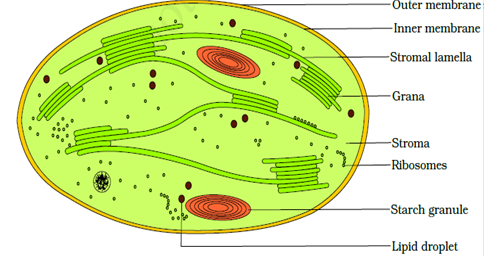
- The membrane system is responsible for synthesizing light energy for the synthesis of ATP and NADPH. In stroma enzymatic reactions incorporate in plants leading to synthesis of sugar.
- The reaction in which light energy is absorbed by grana to synthesis ATP and NADPH is called light reaction. The later part of photosynthesis in which is reduced to sugar, light is not necessary and is called dark reaction.
Pigments involved in Photosynthesis – Chromatographic separation of leaf pigments are as follows-
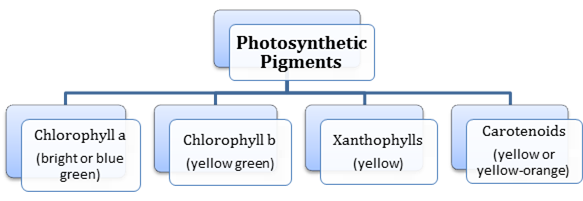

Maximum absorption by chlorophyll a occurs in blue and red regions having higher rate of photosynthesis. So, chlorophyll a is the chief pigment.
- Other thylakoid pigments like chlorophyll b, xanthophyll and carotenoids are called accessary pigments that absorb light and transfer energy to chlorophyll a and protect them from photo-oxidation.
Light reaction
- Light reaction(photochemical phase) includes:
- Light absorption
- Water splitting
- Oxygen release
- Formation of high energy chemical intermediates (ATP and NADPH).
- The pigments are organized into two discrete LHC( light harvesting complex) within photosystem I and photosystem II.
- LHC are made up of hundreds of pigments molecules containing all pigments except single chlorophyll a molecules in each PS.
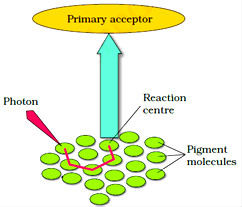
- The pigments in photosystem I and photosystem II absorbs the lights of different wavelength. Single chlorophyll a molecule makes the reaction centre. In PS I reaction centre has highest peak at 700nm, hence called P700. And PS II reaction centre has highest peak at 680 nm, so called P680.
The Electron Transport System
- Reaction centre of photosystem II absorbs light of 680 nm in red region and causing electron to become excited. These electrons are picked by an electron acceptor which passes to electron transport system consisting of cytochromes.
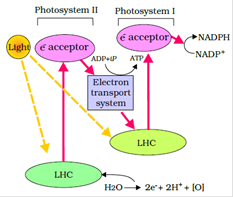
- Electrons are passed down the electron transport chain and then to the pigment of PS I.
- Electron in the PSI also get excited due to light of wavelength 700nm and are transferred to another accepter molecule having a greater redox potential.
- When electron passes in downhill direction, energy is released. This is used to reduce the ADP to ATP and NADP+ to NADPH. The whole scheme of transfer of electron is called Z-scheme due to its shape.
- Photolysis of water release electrons that provide electron to PS II. Oxygen is also released during this process.
- Difference between cyclic and non-cyclic photophosphorylation
Cyclic photophosphorylation | Non-cyclic photophosphorylation |
|
|

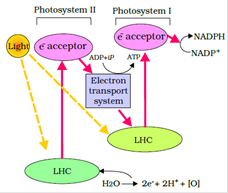
Chemiosmotic Hypothesis of ATP FORMATION
This hypothesis was proposed by Mitchell in 1961. ATP synthesis is linked to development of proton gradient across the membrane of thylakoid and mitochondria.
The process that causes development of proton gradient across the membrane is-
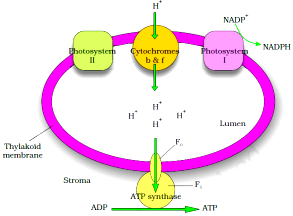
- Splitting of water molecules occurs inside the thylakoid to produce hydrogen ion or proton.
- As electron passes through the photosystems, protons are transported across the membrane because primary acceptor of electron is located towards the outer side the membrane.
- The NADP reductase enzyme is located in the stroma side of membrane. Electrons come out from the acceptor of electron of PSI, protons are necessary for reduction of NADP+ to NADP + H+. These protons are also removed from the stroma. This creates proton gradient across the thylakoids membrane along with pH in the lumen.
- Gradient is broken down due to movement of proton across the membrane to the stroma through trans-membrane channel of F0 of ATPase. One part of this enzyme is embedded in membrane to form trans-membrane channel. The other portion is called F1that protrudes on the outer surface of thylakoid membrane which makes the energy packed ATP.
- ATP and NADPH produced due to movement of electron is used immediately to fix CO2 to form sugar.
- The product of light reaction used to drive the process leading to synthesis of sugar are called biosynthetic phase of photosynthesis.
Calvin Cycle/C3 cycle/Reductive Pentose Sugar Phosphate Pathway
Malvin Calvin, Benson and their colleagues used radioactive 14C and Chlorealla and Scenedesmus algae to discover that first fixation product is 3-carbon organic compound (3-phosphoglyceric acid) or PGA. Later on a new compound was discovered which contain 4-carbon called Oxaloacetic Acid (AAO). On the basis of number of carbon atoms in first stable product they are named C3 and C4 pathway.
Calvin cycle can be described under three stages: carboxylation, reduction and regeneration.
- Carboxylation is the fixation of into 3-phosphoglyceric acid (3-PGA). Carboxylation of RuBP occurs in presence of enzyme RuBP carboxylase (RuBisCO) which results in the formation of two molecules of 3-PGA.
- Reduction is series of reaction that leads to formation of glucose. Two molecules of ATP and two molecules of NADPH are required for reduction of one molecules of . Six turn of this cycle are required for removal of one molecule of Glucose molecules from pathway.
- Regeneration is the generation of RuBP molecules for the continuation of cycle. This process require one molecules of ATP.
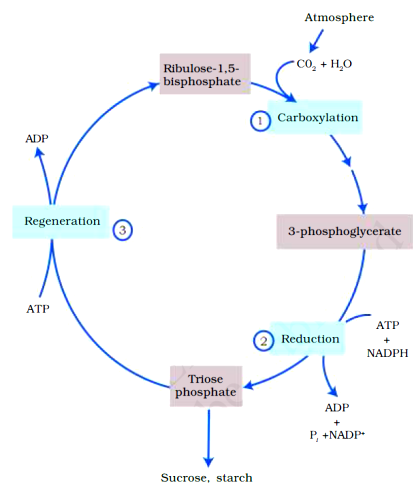
Fig-Calvin Cycle/ C3 Cycle
- For every molecules of entering the Calvin Cycle, 3 molecules of ATP and 2 molecules of NADPH is required. To make one molecules of glucose 6 turns of cycle is completed so total energy molecule required is
In | Out |
Six 18 ATP 12 NADPH | One glucose 18 ADP 12 NADP |
C4 pathway/Hatch Slack Pathway
- This pathway was worked out by Hatch and Slack (1965, 1967), mainly operational in plants growing in dry tropical region like Maize, Sugarcane, Sorghum etc.
- In this pathway first stable product is a 4-carbon compound Oxaloacetic acid (AAO) so called as pathway. plants have Kranz Anatomy (vascular bundles are surrounded by bundle sheath cells arranged in wreath like manner), characterized by large no of chloroplast, thick wall impervious to gases and absence of intercellular spaces.
- The primary acceptor is a 3-carbon molecule Phosphoenol Pyruvate present in mesophyll cells and enzyme involved is PEP carboxylase.
- OAA formed in mesophyll cell forms 4-carbon compound like malic acid or aspartic acid which is transported to bundle sheath cells.
- In bundle sheath cell, it is broken into and a 3-carbon molecule. The 3-carbon molecule is returned back to mesophyll cells to form PEP.
- The molecules released in bundle sheath cells enters the Calvin cycle, where enzyme RuBisCO is present that forms sugar.
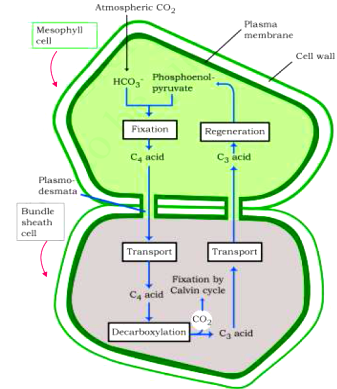
Photorespiration
- It is a the light dependent process of oxygenation of RuBP and release of carbon dioxide by photosynthetic organs of plants.
- Photorespiration decreases the rate of photosynthesis when oxygen concentration is increased from 2-3% to 21%.
- Presence of light and higher concentration of Oxygen results in the binding of RuBisCO enzyme with O2 to form.
RuBisCO + PGA + phosphoglycolate
This pathway involves Chloroplast, Peroxisome and Mitochondria. Photorespiration do not occurs in plants.
C3 plants | C4 plants |
|
|
Factors affecting photosynthesis
- Light- as light intensity increases, the rate of photosynthesis also increases until light saturation point.
- Carbon dioxide concentration- with increase in concentration of rate of photosynthesis increase till the compensation point.
- Temperature- it does not influence the rate of photosynthesis directly but at higher temperature enzyme activity is inhibited due to denaturation of enzymes which affect the dark reaction.
- Water- due to increase in amount of water, rate of photosynthesis does not increase proportionally as after saturation no more water is required during photosynthesis.
Blackman’s Law of Limiting Factors states:
If a chemical process is affected by more than one factor, then its rate will be determined by the factor which is nearest to its minimal value: it is the factor which directly affects the process if its quantity is changed.